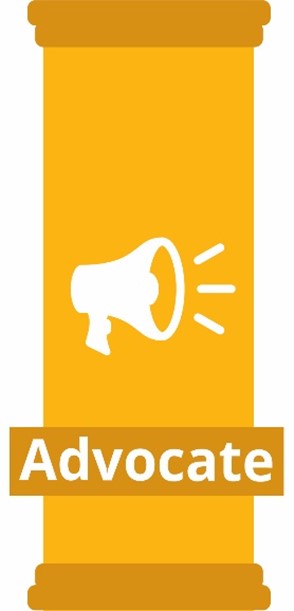Editor’s Note: We conclude our 5-part original series surrounding employee disengagement and the connection to customer loyalty with a description of the final pillar in the model: Advocate. We are grateful to the Employee Engagement experts at Hinda Loyalty for offering this framework for understanding and attacking the issues facing so many of our readers. The 5-part series began with an introduction to The Four Pillars of the New Employee Relationship. The first three pillars — Attracting the Right Personnel, How to Engage and Engagement is a Team Sport — were published previously.
The last entry in the series focuses on the Fourth Pillar: Reconfiguring Employee Relationships and how to advocate on their behalf.
You are invited to attend a free webinar summarizing the entire series on August 24th at 1pm EST. Registration is available here.
By: Theresa Thomas, CLMP™, Hinda and Ric Neeley, Hinda
The first three posts on the New Employee Relationship focused on external branding (attracting), employee needs/wants/desires/goals (engaging), the HUGE role managers play in creating engagement and retention (transmitting). Now, to round out the 4 Pillars, we will discuss how you can help employees “Advocate” for the company to help support the employer brand, increase engagement, and reduce turnover.
Creating Employee Advocates
Employee Advocacy isn’t new, but it has taken on a bigger role in employee engagement than in the past due to social media. Social media puts anything related to sharing information on steroids. Good information about your company can go viral in a minute — think of all the great press Zappos got when it first launched. Or it could hurt you tremendously. Do you remember all the negative posts about Uber when a former employee posted publicly about sexual harassment and discrimination at Uber? It only took one person with an understanding of how social media works to cause irreparable harm and ultimately forced Uber to address their toxic culture in their IPO filing. That’s not a good look.
Smart companies create reasons for employees to feel pride in their company and then manage the various audiences who can provide positive advocacy. They do not just “assume” things are okay.
Definition of Employee Advocacy
What is employee advocacy?
“Employee advocacy is a method used to promote your brand and initiatives through people who work for your organization in an authentic and trusted way, typically on social media or other digital channels.”
However, for our discussion of employee engagement and retention, we add ex-employees to our advocacy discussion. Not every employee leaves a company on bad terms. Some employees find opportunities to grow and do different work that provide benefits that can’t be realized in their current company. How impressive would it be to new candidates and new employees to see and hear people who have left the company sing its praises?
Benefits of Employee Advocacy
A study conducted in 2018 by PostBeyond and Golfdale Consulting showed:
- Company branded messages had a 561% greater reach when shared by employees compared to branded channels.
- 44.5% of people say they are more likely to apply for a job if they saw their friend post about it on social media than they would if they saw the same position on a job board.
In addition, when employees post positively about their company culture, others passively absorb this information. This makes it is easier for recruiters to find more people who are already knowledgeable about, and positively disposed to, the company. See how this dovetails nicely into the “Attract Pillar?”
Who Are Your Advocates?
Current Employees
As we talked about in the "Transmit" post, training and supporting employee social media efforts to positively highlight the company are critical for sharing the organization’s culture and engagement principals. They should be praised for sharing the values instilled in the organization.
Your current employees are your best advocates.
Ex-Employees
All companies experience turnover. It’s normal and natural. But when employees leave a company, many organizations act as if employees who quit no longer exist. But don’t forget, these employees have opinions about your company, your values, your managers, and how it was to work there, etc.
These invisible employees could be actively hurting your reputation — or helping it. You probably don’t know. Making sure your “ex-employees” are working for you and not against you is yet another way to help drive retention and engagement.
Boomerang Employees
A survey of 2,500 U.S. adults conducted earlier this year by The Muse, a job-search and career-coaching company, showed nearly three-quarters of workers who quit to take a new job said they felt regret. Almost half of those workers said they would try to get their old job back. Boomerang employees or those that do return to their former employer will need little time for acclimation but will probably be your best advocates going forward.
Creating Advocates Means Creating Safety and Content
Creating employee advocates isn’t hard. But it takes effort.
Safe To Tweet?
First, employees need to feel comfortable sharing what’s going on at their company and they need to know what and how to share. None of those things are typically second nature to employees. That is where your company’s training on social media — what’s acceptable and what’s not, what is and is not expected — is critical. Employees need to feel safe sharing — and they need guardrails to feel comfortable sharing outside the walls of the company intranet.
Content
Don’t assume your employees know what to share. A few will take to the advocacy game quickly and with enthusiasm. Others won’t. Showing what some employees have shared will provide examples for other employees to see what is acceptable and popular.
Some of the ways you can create content include:
SWAG — well thought out merchandise/items with a company logo can be a nice way to keep your name in front of people.
Recognition and Rewards — make this a priority. People who feel valued love to tell others. Nothing makes someone feel like a valued member of the team more than recognition from their managers, executives and peers. People tell everyone when they are rewarded at work. With the right platform this can also include employee-to-employee recognition, not just manager recognition.
Company Sponsored Tweets/Posts/Etc. — create content to make posting easy. Companies can help by developing editable content to share in a common folder on the intranet or elsewhere. Employees can look for things to share from there and make it their own if they want.
Outreach — connect with past employees and followers on various social sites (Twitter/LinkedIn/etc.) This can be commenting on their posts, sharing their tweets, thanking them for sharing your content. Think of your ex-employees as another target market for recruiting and employee branding. There are many tools that allow you do see what is being posted on various social media channels (Google Alerts, IceRocket, Topsy, etc.)
Steps to Advocacy
1) Get buy-in from your executives and other management levels. They NEED to be playing the game and they need to be visible. If the rank and file don’t see the execs participating in social media, they will assume it really isn’t important.
2) Communicate internally about advocacy. Show how it is done. Share updates, tweets, etc.
3) Ensure managers are talking about advocacy. Make it part of their ongoing management training.
4) Provide training. Start during onboarding and continue with general sharing of advocacy efforts and updates. Make advocacy visible and important in the company.
5) Monitor Activity. Check who is sharing and what they are sharing. Are there some groups doing it better than others (positive deviants)? Find out what they are doing and share their practices. Look for those that aren't playing the game. Find out why. Lack of engagement in this area could be a huge red flag for overall employee engagement or a problem with a manager. You can use technology to monitor activity but also include humans in the equation to make sure things can’t slip by.
6) ACTIVATE advocacy for your company through a referral program. Like the old saw about the tree falling in the forest, even the most engaged and happy employees need a way to be an advocate. Your engagement platform should include rewards for participation and referrals. Create ongoing rewards for bringing new, qualified, and culturally aligned applicants into the company. But don’t punish non-participation. Use surprise and delight awards through an engagement platform when people tweet/post/share. This helps focus your employees on the behaviors and activities you want and gives those a bit reluctant a reason to experiment and to try out sharing. The awards don’t have to be huge, but they do provide a signaling mechanism to your employees that the company finds this activity important and is paying attention to the work they are doing to enhance the company.
Summary
You ask your neighbors who they used to update their home because you think they will tell you the truth and you value their opinion. The same principle applies to your company and its reputation. Employees, ex-employees, and even consumers, all can be trusted advisors. They can reinforce a new employee’s decision to join you or encourage potential recruits to apply.
Either way, your ability to train, promote, support, and help your various audiences share great information about your company will help drive better recruiting, better hiring, better retention and better engagement overall.
Don’t Forget. Get Priority Access
If you didn’t register with any of previous posts in this series, then take a minute and click here to sign up for a complimentary eBook and a reserved spot for our webinar around the 4 Pillars. The webinar will cover all the information in the whole series and during which you’ll have the opportunity to ask questions and engage in dialogue that will help you drive greater employee engagement and advocacy.





